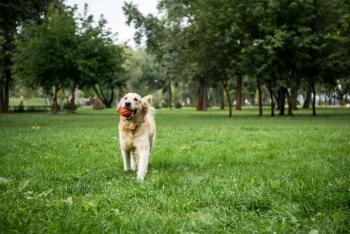
Hot Literature: What can we learn from the consensus statement on leptospirosis?
8 answers to your questions about canine leptospirosis.
A new report, based on a literature review, offers a consensus opinion on leptospirosis and provides evidence-based justification for recommendations regarding the diagnosis, treatment, and prevention of this disease. This consensus statement was presented at the 2010 American College of Veterinary Internal Medicine (ACVIM) forum and was published in the Jan./Feb. 2011 issue of the Journal of Veterinary Internal Medicine.
Here are some of the questions the consensus statement may help us answer.
1. WHAT CLINICAL SIGNS ARE ASSOCIATED WITH CANINE LEPTOSPIROSIS?
While we should still suspect leptospirosis in dogs with kidney or liver disease, the clinical presentation of leptospirosis can vary widely. Some dogs may not even show signs of clinical illness, while others will become severely ill and ultimately die of the disease. Dogs with renal involvement may have signs typical of renal disease such as polyuria, polydipsia, dehydration, vomiting, and diarrhea. It is important to note, however, that infected dogs that are not azotemic may be polyuric and polydipsic. This may be due to a decrease in their glomerular filtration rate or may be a form of acquired nephrogenic diabetes insipidus. Dogs that present with liver involvement may show signs of icterus. Respiratory signs such as tachypnea or dyspnea may be noted in dogs with leptospirosis that have leptospiral pulmonary hemorrhage syndrome (LPHS).
(NATIONAL GEOGRAPHIC/GETTY IMAGES)
2. WHAT ARE THE RISK FACTORS THAT PREDISPOSE DOGS TO LEPTOSPIROSIS?
Typically, dogs become infected with leptospirosis by exposure to contaminated water, soil, food, or bedding that comes in contact with mucous membranes or abraded skin. Outbreaks of leptospirosis tend to be seen after periods of high rainfall, but peak incidence overall varies geographically. Intact male working dogs that are kept outdoors are at risk, but infection may occur in males and females of any breed or age. Dogs that drink from or are exposed to rivers, streams, or lakes may have an increased risk; however, it is important to note that even dogs in urban environments may contract the illness. "In areas where wild animal species access suburban backyards, small-breed dogs with minimal contact with water sources may be at risk," the panel notes.
3. DO CATS BECOME ILL FROM LEPTOSPIROSIS?
Leptospirosis has been isolated from cats, but clinical disease is rare. Whether cats may play a role in environmental contamination is not clear.
4. WHAT IS THE BEST WAY TO DIAGNOSE LEPTOSPIROSIS?
The current test of choice is still the microscopic agglutination test (MAT), which tests for antibodies to various leptospirosis serovars. The concern with this methodology is that interpretation is subjective and standardization is difficult. Dogs that are acutely ill may have negative test results within the first week of illness, so measuring acute and convalescent titers (seven to 14 days apart) is recommended. A fourfold increase in the titer is supportive of a recent infection. Previous vaccination against leptospirosis may also cause an elevated titer, and vaccine serovars may cross-react with nonvaccine serogroups. Postvaccinal titers are expected to be low, but high titers (≥ 1,600) may persist after vaccination. Thus, while a single elevated titer may raise suspicion for leptospirosis, it does not confirm the disease.
In dogs with acute illness (< 10 days) that would likely have negative serologic test results, molecular diagnostics such as polymerase chain reaction (PCR) testing may be more beneficial. In dogs with a history of leptospirosis vaccination and positive serologic test results, PCR testing can confirm active infection. Negative PCR results do not rule out the disease, and the test still needs to be interpreted in conjunction with antibody testing and supportive clinical signs. PCR testing of urine in dogs with known current or previous leptospirosis infection may help identify a chronic carrier state.
5. IF I DIAGNOSE LEPTOSPIROSIS IN A PATIENT, WILL CLINICAL SIGNS OR SEROLOGY RESULTS IDENTIFY WHICH IS THE INFECTIVE SEROVAR?
According to the panel, "at this time, no clear correlation has been made between the suspected infecting serovar based on antibody testing and clinical manifestations of disease in naturally occurring canine leptospirosis." In the future, a combination of tests including genetic studies may ultimately aid in the correlation of clinical signs and infecting leptospiral strain and allow more specific mapping of the geographic distribution of leptospirosis. The treatment of leptospirosis is the same regardless of the infecting serovar.
6. WHAT IS THE BEST WAY TO TREAT LEPTOSPIROSIS?
While the ideal treatment of canine leptospirosis is unknown, the consensus panel recommends treatment with doxycycline (5 mg/kg intravenously or orally every 12 hours for two weeks). If doxycycline is not available or not tolerated by the patient, ampicillin (20 mg/kg intravenously every six hours) should be given. This dose should be reduced for azotemic dogs. Once the patient is able to take oral medications again, doxycycline should be administered for two weeks to clear the organisms from the renal tubules.
The prognosis for dogs that are treated appropriately and aggressively and that do not have complicating respiratory involvement is good. Renal parameters would be expected to return to normal by two weeks, although it may take more than four weeks in some cases. In some dogs, permanent kidney damage may occur. Once a patient is discharged from the hospital, follow-up examinations will vary depending on the severity of illness. The panel recommends, at minimum, a follow-up visit one week after discharge to perform a serum chemistry profile and urinalysis and, if indicated, a complete blood count.
7. WHAT ARE THE ZOONOTIC CONCERNS WITH LEPTOSPIROSIS?
Most human cases of leptospirosis in the United States result from recreational water activities. The incidence of transmission from pet contact is low; however, while the risks of zoonotic exposure require further study, appropriate handling of these patients is warranted.
Pregnant or immunocompromised individuals should avoid contact with patients suspected of having leptospirosis. Antimicrobial therapy may help lessen zoonotic risk by decreasing the amount of organisms shed in the urine. Movement of these patients around the hospital should be kept to a minimum, but because dog-to-dog transmission is rare and these patients typically require more intensive monitoring, the panel does not feel they need to be kept in isolation. Disposable gowns, gloves, facemasks, and protective eyewear should be worn when cages are cleaned or infected urine is handled. Because of the risk of aerosolization of infective organisms, pressure washing of runs should be avoided.
Patients should be allowed to urinate in a restricted area that can be easily disinfected, and disposable bedding should be placed in biohazard bags. Other bedding can be laundered normally to inactivate leptospires. Urine collected from infected dogs—such as those with indwelling urinary catheters—should be disinfected before disposal. A 1:1 combination with a 10% bleach solution is effective, as are iodine-based disinfectants, quaternary ammonium solutions, or accelerated hydrogen peroxide.
All blood, tissues, and urine from infected dogs should be handled as medical waste and disposed of according to local regulations. All personnel in contact with infected dogs should be informed of the risks so that proper precautions may be taken.
Once these patients are home, owners should still avoid contact with their dogs' urine until antimicrobial therapy is completed and should wash their hands after touching the dogs. Vaccination of other dogs in the household at risk of exposure may help decrease zoonotic potential.
The consensus panel recommends that other dogs in the household be treated with a two-week course of doxycycline if there is a common source of exposure. Monitoring of acute and convalescent titers in these dogs is also recommended.
8. WHAT ABOUT LEPTOSPIROSIS VACCINATIONS?
While there have been concerns in the past regarding the safety of leptospirosis vaccines, a large study published in 2005 found these vaccines to be no more reactive than other canine vaccines. At this time, there has been no evidence of leptospirosis in dogs that have received the four-serovar vaccines; however, data are insufficient regarding the prevalence of leptospirosis in this population of dogs. The consensus panel recommends that dogs considered to be at risk for leptospirosis infection be vaccinated annually with the four-serovar vaccine.
To read the complete consensus statement, go to
This "Hot Literature" was provided by Jennifer L. Garcia, DVM, DACVIM, a veterinary internal medicine consultant in Houston, Texas.
Newsletter
From exam room tips to practice management insights, get trusted veterinary news delivered straight to your inbox—subscribe to dvm360.






